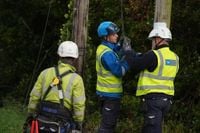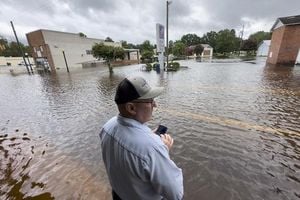In the aftermath of Storm Amy, communities across Scotland, Northern Ireland, and the Republic of Ireland are picking up the pieces, as power and essential services are gradually restored following one of the most severe storms to hit the region in recent memory. The storm, which swept through the area beginning Friday, October 3, 2025, unleashed record-breaking winds, widespread flooding, and left tens of thousands without electricity and water. As recovery operations continue, the resilience of both emergency crews and local residents has come sharply into focus.
According to Scottish and Southern Electricity Networks (SSEN), power had been restored to 71,000 homes in Scotland by Sunday, October 5, 2025. However, roughly 17,000 properties remained without electricity as of that evening, with teams working tirelessly to address outages amid challenging conditions. Nik Wheeler of SSEN described the situation, stating, “Our huge reconnection operation is progressing well, although access challenges due to storm debris and fallen trees remain a concern. There are even more engineers out on the network today than yesterday, thanks to the arrival of dozens more teams from our fellow network operators and contract partners. They've come here from all over the country, and we're grateful for their help.”
The storm’s ferocity was underscored by wind gusts reaching 96 mph in the Inner Hebrides, and hundreds of trees were toppled, causing extensive damage to buildings and infrastructure. The Met Office confirmed that Storm Amy set a new record for the deepest area of low pressure in the UK for the month of October, a statistic that highlights the exceptional nature of the event. The Environment Agency Sepa warned that wave overtopping and localized flooding could persist along northeastern coasts and the Northern Isles into Monday, October 6, 2025.
Rail and road networks bore the brunt of Amy’s impact. Network Rail Scotland reported attending over 420 separate incidents during the weekend, including 60 in the first two hours alone. Several railway lines in northern Scotland were closed as a precaution, but the storm’s rapid intensification forced the closure of all lines out of Glasgow and routes in southern Scotland without warning. ScotRail services on key routes, such as the West Highland Line and the Inverness to Kyle line, remained cancelled due to complex repairs. In Glasgow, part of the Broomielaw was cordoned off after a derelict building collapsed, while in Inverness, a large shop front sign was torn from its moorings at Inshes Retail Park.
Communities across the region demonstrated remarkable solidarity and resourcefulness. In Fort William, a family recounted the “petrifying” experience of a tree smashing through their home’s windows. In Angus, Montrose FC called upon “fit and able supporters” to help clear debris after the boundary wall at Links Park stadium was blown over. Welfare operations, including hot food vans, were mobilized to provide essential support to those in need.
Across the Irish Sea, Ireland faced its own share of devastation. According to the National Directorate for Fire and Emergency Management (NDFEM), recovery operations were well underway by Sunday, October 5, with most homes and businesses reconnected to electricity and water supplies. Still, some households, especially in remote or hard-to-reach areas, remained without essential services. The NDFEM, which chaired a meeting of the National Severe Weather Humanitarian Group on Sunday morning, noted “significant improvements” across all affected counties, though the work was far from over.
Storm Amy brought the strongest winds to Ireland since Storm Éowyn, with Malin Head in Donegal and Magilligan in Derry both recording gusts of 148 km/h (92 mph). The UK Met Office confirmed that Magilligan’s reading was the highest ever recorded in October for Northern Ireland. The storm’s toll was not just material: in County Donegal, a man in his 40s lost his life in a weather-related incident on Friday, October 3, 2025.
At the height of the storm, approximately 184,000 properties in the Republic of Ireland and 65,000 in Northern Ireland were without power. By Sunday evening, ESB Networks reported that the majority of those affected would be reconnected by nightfall, with only remote and difficult-to-reach locations likely to remain in the dark into Monday. Uisce Éireann (Irish Water) indicated that about 4,000 homes—mainly in County Donegal—were without water as of Saturday, but crews were working “as quickly as possible” to restore supply.
Public services scrambled to adapt. All trains, including cross-border services, were cancelled on Friday night and for much of Saturday morning. By Sunday, Translink confirmed that most bus and rail services had resumed normal operation. The Education Authority in Northern Ireland reported that 33 schools had experienced storm-related incidents, primarily roof damage and fallen trees, with about 90 schools losing power. Thankfully, supply was restored to all, and no schools were expected to close on Monday as a result of storm damage.
Infrastructure Minister Liz Kimmins acknowledged the extraordinary efforts of response teams, stating, “They have been working hard to clear the affected parts of our road network, to mitigate the effects of flooding through proactive measures, maintaining critical drainage infrastructure as well as restoring power and water to homes and getting the public transport network back to normal. This is the work that so often goes unseen but is essential in reconnecting our communities and making our road network safe.”
Community assistance centres and support hubs played a vital role in helping those most affected. In Donegal, eight community support centres remained open to provide basic services, and similar facilities were established in Northern Ireland for those without electricity. Residents facing urgent financial need were advised to contact the Community Welfare Service, while ESB Networks and NIE Networks urged the public to avoid downed power lines and promptly report any damage.
Telecommunications infrastructure also suffered, with Fibrus reporting approximately 1,000 customer-reported fibre faults and 108 network damages. Openreach engineers were “out in force assessing and repairing reported damage as soon as it was safe to do so,” but acknowledged that broadband service restoration was dependent on the return of power to affected areas.
Looking ahead, there is some relief in the forecast. Met Éireann predicted settled conditions with dry and sunny spells in the coming days, offering a much-needed respite as recovery and repair efforts continue. The storm season, which began in September, is expected to bring further named events, but as of Sunday, there were no immediate signs of the next major weather system, Storm Bram, making an appearance.
While Storm Amy’s record-breaking winds and widespread damage have tested the resilience of communities across Scotland and Ireland, the rapid and coordinated response from emergency crews, utility workers, and local residents has demonstrated the strength and solidarity that emerges in times of crisis. As the skies clear and the last of the outages are resolved, the region is left with a renewed sense of unity—and a reminder of nature’s unpredictable power.





